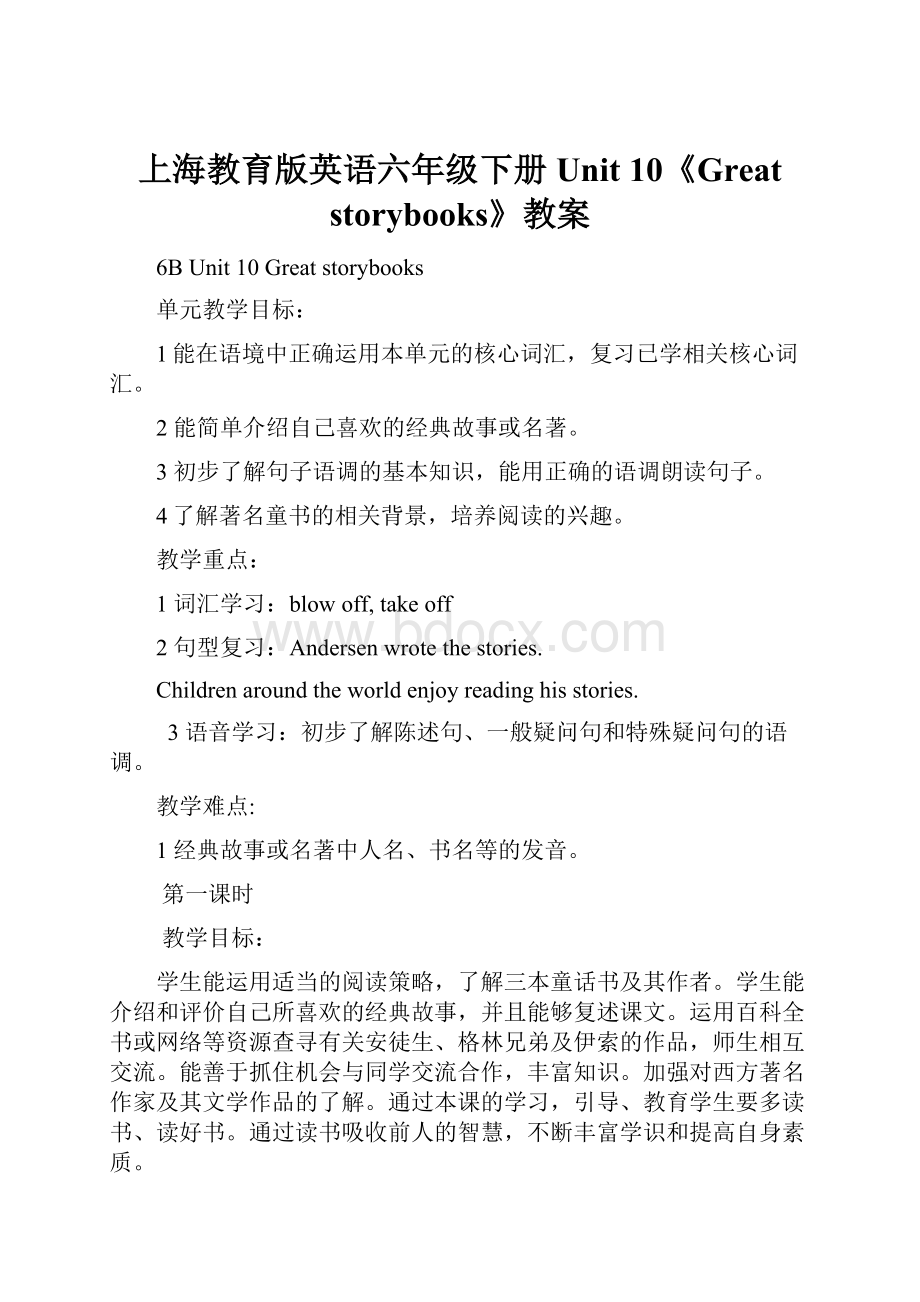上海教育版英语六年级下册Unit 10《Great storybooks》教案.docx
《上海教育版英语六年级下册Unit 10《Great storybooks》教案.docx》由会员分享,可在线阅读,更多相关《上海教育版英语六年级下册Unit 10《Great storybooks》教案.docx(9页珍藏版)》请在冰豆网上搜索。

上海教育版英语六年级下册Unit10《Greatstorybooks》教案
6BUnit10Greatstorybooks
单元教学目标:
1能在语境中正确运用本单元的核心词汇,复习已学相关核心词汇。
2 能简单介绍自己喜欢的经典故事或名著。
3 初步了解句子语调的基本知识,能用正确的语调朗读句子。
4了解著名童书的相关背景,培养阅读的兴趣。
教学重点:
1 词汇学习:
blow off, take off
2 句型复习:
Andersen wrote the stories.
Children around the world enjoy reading his stories.
3 语音学习:
初步了解陈述句、一般疑问句和特殊疑问句的语调。
教学难点:
1 经典故事或名著中人名、书名等的发音。
第一课时
教学目标:
学生能运用适当的阅读策略,了解三本童话书及其作者。
学生能介绍和评价自己所喜欢的经典故事,并且能够复述课文。
运用百科全书或网络等资源查寻有关安徒生、格林兄弟及伊索的作品,师生相互交流。
能善于抓住机会与同学交流合作,丰富知识。
加强对西方著名作家及其文学作品的了解。
通过本课的学习,引导、教育学生要多读书、读好书。
通过读书吸收前人的智慧,不断丰富学识和提高自身素质。
教学重难点:
句型复习:
Andersen wrote the stories.
Children around the world enjoy reading his stories.
教学方法与手段:
本节课我采用导学自悟法,对话法进行教学。
采用PPT课件,卡片,录音机作为教学辅助手段。
使用教材构想:
本节课学生在对课文进行整理,理解基础上,构建思维导图,并根据思维导图进行问答,介绍自己喜欢的作品。
教学方法和过程:
Pre-task preparations
1 用图片的形式展示一些童书的封面,让形式试着说说这些书名,中英文均可。
同时出示这几个作者的照片。
T:
(show the covers of the books)Look at these books. Did you read them?
S1:
Yes, I did. It’s Andersen’s Fairy Tales...
T:
(show some pictures of the writers)Do you know who wtote these books?
These are the writes. Who is he?
S2:
He’s Andersen.
学生尝试将人物图片和书配对。
2教师说出答案,引导学生正确朗读每本书的名称和作者的名字,引出主题。
T:
Aesop’s Fables. Do you know who wrote it?
S1:
Aesop.
T:
Andersen’s Fairy Tales. Who wrote it?
S2:
Andersen.
Grimms’ FairyTales. Who were the writers?
S3:
The Grimm brothers.
...
While-task procedures
1 教师出示一些故事名称及Listen and say的后续练习,让学生根据已有知识先念一下故事名,并说说是谁写的。
T:
Here are some stories. Did you read any of these stories before?
S1;Yes, I read “Snow White”.
S2:
I know “Cinderella.”
T:
Do you know who wrote these stories?
Ss:
No.
T:
Today we’re going to find out who wrote these stories.
播放课文录音,让学生边听边看,了解课文大意。
2 将学生分成三人小组,每人负责一段,先自行阅读,然后在小组中朗读,并将相关阅读信息告诉组员,其他学生核对正误,小组共同完成后续练习。
T:
Now read in groups. First, read it once or twice by yourselves. Then read it to your group. Tell your group members what stories the writers wrote.
S1:
(read Paragraph1)Andersen wrote “The emperor’s new clothes” and “The ugly duckling”.
S2:
(read Paragraph2)The Grimms brothers wrote “Snow White”,”Little Red Riding Hood” and “Cinderella”.
S3:
(read Paragraph3)Aesop wrote”The fox and the grapes”,”The wind and the sun”,”The farmer and the snake”.
3小组内说完以后,教师请若干小组说说。
接着让学生独立朗读课文,完成Listen and say的后续练习。
然后让学生试着介绍三个作者及其作品。
S1:
Andersen was a Danish writer. He wrote Andersen’s Fairy Tales. “The emperor’s new clothes” and “The ugly duckling”are from thebook.
4 提出问题,帮助学生进一步了解相关作家。
可以采用思维导图的方法,让学生补充更多关于作者的信息,通过引导性问题帮助学生提取核心信息。
Aesop was a famous writer.
1)Where did he come from?
2)What book did he write?
3)What is the book about?
4)Why is his book so famous?
/Whydo people like his book?
用同样的方式帮助学生了解Andersen和the Grimms brothers。
Post-task activities
1 学生通过上一个练习对作者有一个更具体的认识之后,教师可以运用思维导图作提示,帮助学生口头表达。
每个学生选一位作家的思维导图,对该作者的作品等具体内容进行介绍。
本练习按照学生的能力弹性处理,如果学生不能用核心词汇及句型组织语言,可以使用课文中的内容来介绍。
S1:
I want to tell you something about the writer Andersen. Andersen was a Danish writer. He is a famous book called Andersen’s Fairy Tales. In thisbook, there are many interesting fairy tales such as “The ugly duckling”and”The emperor’s new clothes”. Children like reading these stories a lot. I like ”The emperor’s new clothes”best.
2 学生补充一下自己对作者或作品的认识。
教师可鼓励学生通过网络等平台寻找更多关于作者的信息,帮助学生丰富主题内容的语言。
板书设计:
Unit 10 Great storybooks
Name of the book
writer
nationality
stories
Andersen’s Fairy Tales
Andersen
Danish
The ugly duckling,
The emperor’s new clothes
Grimms’s Fairy Tales
The Grimms brothers
German
Snow White,Little Red Riding Hood and Cinderella
Aesop’s Fables
Aesop
Greece
The fox and the grapes,The wind and the sun,The farmer and the snake.
Homework
1. Read “listen and say”two times .
2. Collectsomeotherstoriesofgreatstorybooks.
第二课时
教学目标
1. 通过阅读《伊索寓言》故事《风和太阳》,学习相关语言知识,感受诗歌语言的韵律和美。
2. 通过完成课后练习,引发学生思考并理解故事的寓意。
3. 通过Doasurvey的活动,帮助学生操练和巩固语言知识。
4,通过学习学生懂得劝说比强迫更有效的道理。
引导、教育学生要多读书、读好书。
通过读书吸收前人的智慧,不断丰富学识和提高自身素质。
教学重、难点
1. Words and Phrases:
blowoff takeoff
2. Sentencesreview:
I’llblowoffhisclothes.
3. Daily English:
Let’ssee.Yourturn.
Step One:
Pre-task preparations
1.Greeting.
2. Free talking
T:
Pleaseintroduceoneofthewriters.
S1:
IwanttotellyousomethingaboutthewriterAesop.HewroteAesop’sFables.Inthebook,therearemanyfablesaboutanimals.
T:
Good.TodaywearegoingtolearnastoryfromAesop’sFables.“Thewindandthesun”Doyouknowanythingaboutthestory?
Let’slearnittogether.
Step Two:
While-task procedures
1.Playthestory(PPT)/Read the story /Answerthequestions
(1)(Whichbookisthestoryfrom?
(2) Whoareinthestory?
(3)Whoisstronger.MrWindorMrSun?
(4)Whatcanyoulearnfromthisstory?
2. Read again.(Answerthequestions P65)
Step3.Post-task activities
1. Retell thestory .
Oneday,thewindmetthesun.Hethoughthewas_________thanthesun.Butthesundidnotthinkso.
MrWindblew________.
MrSunmadetheplants________.
MrWindtriedto_______theman’sclothes.MrSunwentbehinda________.
Themanfelt________andhe________hisscarf.
MrSun________.
ItwasMrSun’sturn.
Hebeganto_________.
Themanfelt______.
He_________hisclothesandwent__________.
Atlast,________won.
2.Actitout.
Homework
1. Tell the story to your parents .
2.Readotherstoriesyoulike.
板书设计 Unit10Greatstorybooks
blowoff takeoff
吹掉 脱下
Puton穿上
第三课时
教学目标:
1 通过Doasurvey的活动,帮助学生操练和巩固语言知识,相互了解同学最喜欢的故事;
2通过Thinkandwrite的写作活动,帮助学生巩固和综合运用语言知识。
3. 通过Learnthesounds 的教学活动,帮助学生了解句子的语调。
2. 教学重、难点
学习句子的语调。
Step One:
Pre-task preparations
1.Quickresponse
T(showsomepicturesofthestories)
S1:
“Theemperor’snewclothes”
S2:
“SnowWhite”
S3:
“Thefoxandthegrapes”
S4:
“Cinderella”
2.Talkingroups
T:
Didyoureadthesestories?
Pleasepickouttheonesyoureadandtellyourgroupwhatthestoriesareabout.
S1:
Ireadthestory“Theuglyduckling”It’saboutanuglyduckling.Hebecomesabeautifulswan.
S2:
Ireadthestory“Theemperor’snewclothes”It’saboutanemperor.Helikednewclothes.Hewassilly.Hewalkedinthestreetwithoutanyclothes.
S3:
Ireadthestory“Thefoxandthegrapes”.It’saboutafox.Hewantstoeatthegrapesbuthecan’tgetit.Sohethinksthatthegrapesaresour.
Step Two:
While-task procedures
1.T:
What’syourfavoritestory?
S1:
Myfavoritestoryis…
T:
What’sthestoryabout?
S1:
It’sabout….
T:
Whowrotethisstory?
S1:
…
2.Doasurvey.
学生分组,根据以上方式进行问卷。
S1:
What’syourfavoritestory?
S2:
Myfavoritestoryis…
S1:
What’sthestoryabout?
S2:
It’sabout….
S1:
Whowrotethisstory?
S2:
…
3.学生整理信息,汇报调查结果。
4.Learnthesounds
1)出示句子1.Arethesepens↗yours?
Yes,they↘are
说明:
向上的箭头表示升调,向下的箭头表示降调。
2)播放录音,学生模仿。
Step3.Post-task activities
教师出示Thinkandwrite的写作练习。
让学生思考自己喜欢的故事。
Myfavouritestoryis“…”
It’sabout…
…wrotethisstory.
板书设计
Unit10Greatstorybooks
Myfavouritestoryis“…”
It’sabout…
…wrotethisstory.
Homework
Askyour parentswhattheir favouritestoriesare,thenwritethemdown.